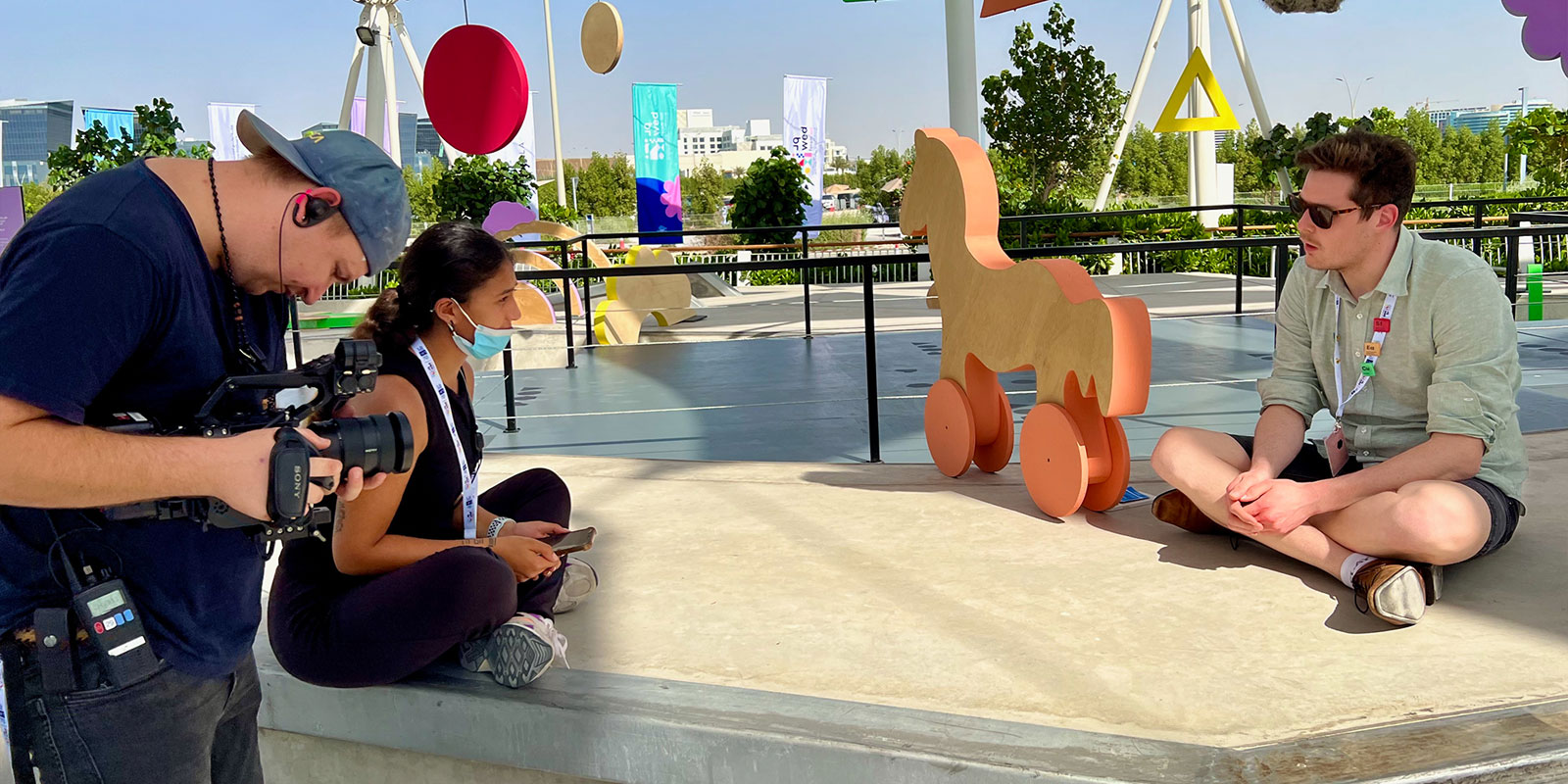Leadership training doesn’t go far enough.
For real change, you need an evolution, not a one-off.
dpurposefuldev on March 7, 2024
For real change, you need an evolution, not a one-off.
dpurposefuldev on March 7, 2024
To find examples of bad leadership, we don’t have to go far. Turn on the news, and you’ll likely find multiple stories of high-profile people making poor choices, often at the expense of others.
dpurposefuldev on February 5, 2024

Picture a typical desk in a corporate office. A half-drunk mug of coffee sits next to a keyboard. A large monitor is illuminated with work in progress. A jacket is flung casually over the back of an empty chair.
You’d assume, looking at this scene, that it’s occupier – the man who spends his days sitting in that chair, drinking from that mug, and working on that computer – had simply slipped off to the bathroom or popped out to pick up lunch.
What you might not realise is that this man is already half way home. His perfect “mid-task” desk set-up is just that – a set-up, created to make you, and anyone else who happens to be walking by, believe he’s working longer hours than he is.
The sad truth is, this man is like many men (and women) working in the upper ranks of companies; in order to survive in his system, he has to create an illusion of diligence and dedication.
This story might sound ridiculous – but it’s absolutely true. Over the years, I’ve heard many stories just like this. Grown men, often senior executives who are otherwise honest at work and at home, will go to great lengths to “stage” an alternate reality in line with their perceived expectations.
Every time I hear a story like this, I wonder: What are we role modeling as men (and women)? Or more accurately, why do we continue overplaying the toxic masculine in our systems?
Globally, we’ve made significant progress in increasing gender diversity in the upper echelons of the corporate world. Women are becoming more present – and yet still, in many cases, femininity is still underplayed and undervalued.
Many organisations continue to place too great a value on conventional toxic “masculine” traits, like dominance, toughness, silent dedication, and competition. So much so, in fact, that much of our research shows organisations have not so much embraced their feminine sides, as women have taken on more masculine traits to gain acceptance.
What we know from our work is as follows: Culture and systems that put equal and balanced value on perceived masculine and feminine energy – and don’t over-rotate toward one or the other – tend to be the highest performing, the most productive, and the most fulfilling for people.
Crucially, where that energy comes from – biological men or women – is immaterial. In fact, individuals of every gender and/or sex who embrace and express both traditional masculine and feminine traits are also generally happier, more fulfilled and more productive.
Case in point: A study in the Journal of Organisational Behavior found that men who exhibited traditionally feminine traits like empathy, and women who exhibited traditionally masculine traits like assertiveness were perceived as more effective by their employees. Similarly, a study in the Journal of Vocational Behavior revealed that men and women with a combination of masculine and feminine traits tended to have higher job satisfaction and better mental health.
In our complex world, we need adaptive organisations and leaders who can shift their energy and style dependent on context. Empowering them to embrace both their masculine and feminine sides assists in that resilience.
The other dynamic at play here is the toxic versus the generative. In other words, both the feminine and the masculine have helpful and unhelpful traits. Leaning too hard on the masculine, for example, often tips over from the generative – think integrity, confidence and leadership – into the toxic – aggression, arrogance and superiority. When this happens, everyone in the system suffers.
Recently, the leadership team of one of our client organisations took ambitious steps to incorporate care (often considered a feminine trait) as a leadership principle. The resulting behavioural change expressed through the leadership led to improved employee retention and engagement. Not only that but the leaders have reported that embedding care has helped them to better navigate difficult challenges.
The answer to centuries of toxic masculinity is not the adoption of this energy by others to belong, or even a pendulum swing towards a new norm of toxic femininity. It’s a collapse of the idea of any stereotyping and a focus on our own ‘inner’ work as individuals and teams to help us all be more generative in our ways of working and leading. In that way, we can embrace and transform our own unhelpful traits.
Returning to the man at the start of this article, at the time, he said to me in private, “The worst part is that I don’t feel comfortable speaking my human need to spend time with my family.” It broke my heart: The cost to all of us of this toxic masculinity playing out in the workplace is that it deprives us of the very things that matter most.
It’s time for a new paradigm – a new “leadership energy” that breaks down the feminine vs masculine, and instead takes the most generative traits of both.
Toxic masculinity overplays the left column and underplays the right (Harvard Business Review 2022)
To find examples of bad leadership, we don’t have to go far. Turn on the...
Shhh…can you hear that? That’s the sound of listening finally taking its rightful place in...
Purposeful Change on December 22, 2023

Shhh…can you hear that? That’s the sound of listening finally taking its rightful place in the boardroom.
In a world gone crazy for immediate results, where we are expected to know our s*** and the loudest voice often wins, some enlightened organisations are taking a different approach. In simple terms, they’re slowing down, shutting up and putting the listening at the heart of their corporate strategies. They are listening to learn.
It might sound simple: Listening, after all, is a long-standing and widely accepted human function essential to communication and healthy relationships. But the type of strategic listening we’re helping businesses develop isn’t business as usual in most of the cultures.
Instead, across our diverse portfolio of client sectors and types, we’re seeing today’s leading businesses take a radically different approach to listening. This “listening leadership” is both active and generative – and it’s taking their understanding of the people they serve to unprecedented new depths.
We’ve all been there. We’re sitting across from a chatting colleague, friend or family member–and we’re waiting to speak. Sure, we’re hearing what they’re saying, but we’re also judging it in real time. Rather than really tuning into their perspective, we’re searching for the thread that affirms our own world view. By the time their lips stop moving, we’re ready to respond through the lens of our own experience.
“Listening to respond” and “listening to affirm” has long been a limitation for many of us as individuals, but it’s also an enormous issue for many organisations. Their intentions are pure, of course – they seek feedback, opinions and input from their customers, people and other stakeholders and take action in response. All good, right?
The problem is the way in which they’ve asked the questions, summarised the results, and formulated the response. All reflect aspects of what’s true about their audiences, but they are wrapped up in what’s true about themselves.
Just the other day, we were speaking to a leadership team who was on the receiving end of an internal pulse survey with some less-than-favourable results. At first, there was panic – “We have to do something about this” – but it soon turned to rationalising. Among other things, we heard: “Compared to other companies like ours, it’s not that bad” and “We are getting this response because we haven’t yet had a chance to implement our new performance management system – things will change.”
By the time the conversation was finished, they’d neatly folded what was effectively a cry for help from their organisation into their own reality. As you imagine, had they proceeded from that point, none of their people’s concerns would have been addressed, and in fact, their inadequate actions might have done more harm than good. They, like all organisations, rely on an understanding of their stakeholders to achieve their goals – failing to properly listen risks their very existence.
One of the UK’s most successful grocery chains – Co-op Food – made headlines earlier this year for its 9-point plan to increase social mobility through its community-based hiring and retention strategies. At the heart of that strategy? You guessed it: Listening.
Co-op realised that in order to genuinely achieve their purpose and “break the class ceiling” (and not just provide lip service to it), they couldn’t simply sit back and interpret what they heard from people through their own lenses. Instead, they had to actively listen.
Active listening is listening to create belonging. It’s listening to create safety. It’s listening to learn. By moving beyond information and even empathy, we can occupy the space author Otto Scharmer refers to as “generative listening.”
As he explains in his book ‘Theory U,’ with this type of listening, organisations set aside their own egos and open themselves up to a new understanding. They do this by “listening and taking onboard the attitudes and emotional responses of others to the subject in question.”
For our clients now making listening a part of their strategies, this approach has been transformative. It has helped them to develop a far more profound understanding of their stakeholders and respond in kind. They are using a listening strategy to create better understanding between customers and colleagues, colleagues and management, and even within themselves as individuals.
Active listening is just that – active. It requires commitment, the right set of skills and behaviours, and a framework against which to measure success. A good starting point is exploring Sharma’s 4 Levels of Listening or Nancy Kline’s Thinking Environment.
From there, it’s about embedding those practices into your strategy and leadership. It’s not easy – but it does work. One business we’re working with reported improved retention rates as a result of better listening. Another, reported a more productive workforce.
All good reasons to sit up and listen.
To find examples of bad leadership, we don’t have to go far. Turn on the...
Picture a typical desk in a corporate office. A half-drunk mug of coffee sits next...